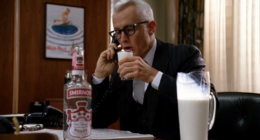Share this @internewscast.com
It’s no secret that everything is bigger nowadays.
Whether it’s houses, TVs or cars – compared to decades ago, things have gone supersized.
And that includes serving sizes and waistlines.
In 2024, 43 percent of Americans were considered obese, compared to just 13 percent in the 1960s.
Experts have blamed an increased intake of ultra processed foods and meals with more calories and warned obesity can lead to a range of health problems, including heart disease, diabetes, high blood pressure, high cholesterol, liver disease, sleep apnea and certain cancers.
And now, California-based nutritionist Autumn Bates has revealed what she believes is driving the obesity epidemic, detailing four reasons as to why people were slimmer in decades gone by, despite exercising less or not having access to fitness monitors like Apple Watches and FitBits.
She says she decided to investigate this phenomenon after watching a YouTube short recently that asked the question why were we so skinny in the 1960s?
The nutritionist said: ‘[This is a] fair question because in the 60s we had an obesity rate in America of about 13 percent.
‘To put that into perspective now currently as of 2025 we have an obesity rate that is closing in on 43 percent and this is all kind of wild because it’s not like people were known in the 60s for their healthy food choices.
‘So why in the world did we have such lower body fat percentages back in the 60s?’

While it’s easy to look at the past with rose tinted glasses, scientists say it’s a cold hard fact that we were much skinnier in the past than today. Above, sunbathers sit in deckchairs at Virginia Beach in the 1960s
The first driving factor behind the rise in obesity is the decline in home-cooked, fresh meals. These used to be the rule; not the exception.
They traditionally featured ‘some type of really high quality protein, some fruit, some bread, some veggies and then probably milk.’
She explains this same nutritious formula applied to children’s packed lunches for school, so kids were getting more of a balanced diet compared to today.
From her research looking at what people ate in the 1960s, Ms Bates says some of the popular items included roast chicken, meatloaf, beef stew, steak and potatoes.
There was little mention of fast food, which has seen a surge in serving sizes – with calorie counts reaching nearly 2,000 for a serving of popular burgers and fries.
From personal interactions with her family, she said in a YouTube video: ‘My dad said that they would pretty much always have like pot roast and my mom has a very specific, not fond, memory of lima [or butter] beans.’
Ms Bates says the benefits of meals prepared at home include a lower sugar intake, extra protein and an increased amount of vegetables.
A previous study from Johns Hopkins University found people who frequently cook their meals at home tend to consume fewer carbohydrates, less sugar, and less fat compared to those who don’t cook as often.
Next, Ms Bates says another reason why today’s society is fatter than ever is because of the explosion of ultra processed foods.
Ultra processed foods, or UPFs, is an umbrella term used to cover anything with a long ingredients list or made with artificial additives like colorings, sweeteners and preservatives that extend shelf life.
Ready meals, ice cream and ketchup are some of the most-loved examples of products that fall under the UPF term, now synonymous with foods offering little nutritional value.
They are different to processed foods, which are tinkered to make them last longer or enhance their taste, such as cured meat, cheese and fresh bread.
Explaining why UPFs are bad, she says: ‘Ultra processed is the next level of processing that really strips down the satiety and make you so much less satisfied from your food and therefore [you] need to eat even more.
‘These are foods that are primarily going to have ingredients that you don’t recognize and typically a long list of ingredients that you would not be able to just get your grocery store and recreate at home.’
Ms Bates says it is estimated that 70 percent of Americans’ diet today is made up of UPFs and ‘some studies have found that these ultra processed foods can make us eat about 800 calories more a day because they are so much less satisfying.’

California-based nutritionist Autumn Bates (pictured above) reveals that in the 1960s America had an obesity rate of around 13 percent but today that number has more than tripled, with it now ballooning at 43 percent

The third thing that contributed to a slimmer society in the 1960s, Ms Bates says is that people were ‘a lot more accidentally active’
Ms Bates advises avoiding the fattening impact of these foods and swap them out for healthier alternatives – packaged snacks with added ingredients can be swapped for fruits, vegetables, nuts, and seeds.
The third thing that contributed to a slimmer society in the 1960s, Ms Bates says is that people were ‘a lot more accidentally active’.
She continues: ‘A large portion of the workforce back then had more physically demanding jobs. They also had a lot less structured activity, meaning that they didn’t really work out.
‘My dad will always say that he was super embarrassed when he was younger because his dad was a health nut at the time and would go for runs and his friends would make fun of him and ask what he was running from because people had more active jobs.
‘They had a full day where they were more active versus a full day of sitting in front of a computer screen and then also probably commuting.’
Ms Bates notes with the rise of technology, people have become more housebound and glued to their screens, so they are getting less physical activity.
She adds: ‘My mom said that if you had to stay inside, that was a punishment when she was a kid. Kids back in the 60s really didn’t have anything inside that would entertain them as much, so they had to go outside and be active and play.’
For people who have computer based jobs, Ms Bates suggests getting a walking desk, so you can walk on a treadmill while you type and keep trim.
On top of this, she recommends three to four days of structured exercise per week, such as strength training.
Lastly, Ms Bates points to a lack of sleep as another problem driving America’s obesity epidemic.
Today the average American adult gets around 7 hours and 10 minutes of sleep per night and successful modern day individuals like Twitter co-founder Jack Dorsey and President Donald Trump have claimed that 4 hours is the optimal amount of sleep.
This compares to the 1960s, when studies show the average was closer to 8.5 hours.
Commenting on this shift in sleeping patterns, Ms Bates says: ‘Less sleep is significantly tied with obesity and weight gain.
‘Low sleep causes increased hunger hormones so you’re going to feel a lot more hungry the next day.
‘It also increases our preferences for sweet foods and it increases our preferences for larger portion sizes.’
The nutritionist blames technology for hampering peoples’ ability to sleep, with more distractions at nighttime in the form of things such as laptops, TVs and phones.
She adds: ‘Plus people were more active throughout the day which meant that they were more tired and actually did want to go to sleep.
‘We need to set bed times again for ourselves because there are so many different temptations to stay up late whether it be like binge watching a Netflix show or just scrolling on your phone.
‘We need to actually set time limits for when we’re going to be going to sleep.’












